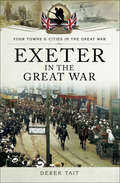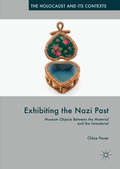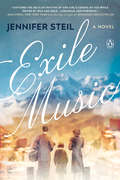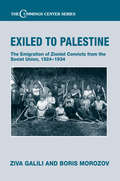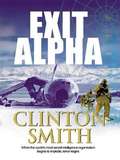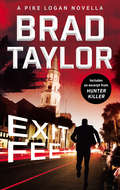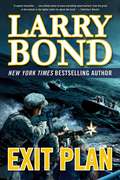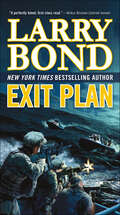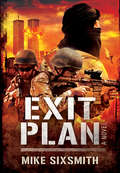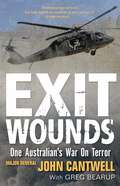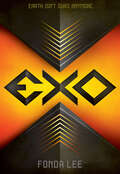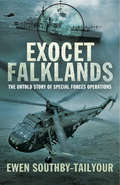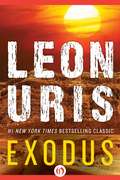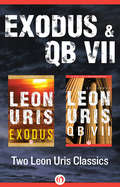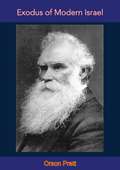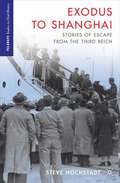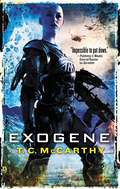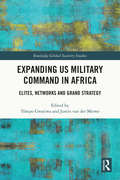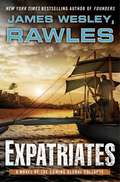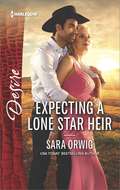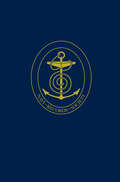- Table View
- List View
Exeter in the Great War (Your Towns & Cities in the Great War)
by Derek TaitExeter played a vital role during the First World War supplying men for the Army and raising funds to help troops overseas. The Mayoress and her team played a key part collecting money to aid homeless Belgian refugees in the city while also supporting other worthy causes both home and overseas. Soldiers travelling through Exeter all received food, refreshments and cigarettes due to the money raised. The city had its own battalion, 'Exeter's Own' and thousands of servicemen passed through the city on their way to northern Europe. Players at Exeter City football club were amongst the first to join the Colours and later the Footballers' Battalion (the 17th Battalion Middlesex Regiment).The effect of the war on Exeter was great. By the end of the conflict, there wasn't a family in Exeter who hadn't lost a son, father, nephew, uncle or brother. There were tremendous celebrations in the streets as the end of the war was announced but the effects of the conflict lasted for years to come.
Exhibiting the Nazi Past: Museum Objects Between the Material and the Immaterial (The Holocaust and its Contexts)
by Chloe PaverThis book is the first full-length study of the museum object as a memory medium in history exhibitions about the Nazi era, the Second World War, and the Holocaust. Over recent decades, German and Austrian exhibition-makers have engaged in significant programmes of object collection, often in collaboration with witnesses and descendants. At the same time, exhibition-makers have come to recognise the degree to which the National Socialist era was experienced materially, through the loss, acquisition, imposition, destruction, and re-purposing of objects. In the decades after 1945, encounters with material culture from the Nazi past continued, both within the family and in the public sphere. In analysing how these material engagements are explored in the museum, the book not only illuminates a key aspect of German and Austrian cultural memory but contributes to wider debates about relationships between the human and object worlds.
Exile Music: A Novel
by Jennifer SteilBased on an unexplored slice of World War II history, Exile Music is the captivating story of a young Jewish girl whose family flees refined and urbane Vienna for safe harbor in the mountains of BoliviaAs a young girl growing up in Vienna in the 1930s, Orly has an idyllic childhood filled with music. Her father plays the viola in the Philharmonic, her mother is a well-regarded opera singer, her beloved and charismatic older brother holds the neighborhood in his thrall, and most of her eccentric and wonderful extended family live nearby. Only vaguely aware of Hitler's rise or how her Jewish heritage will define her family's identity, Orly spends her days immersed in play with her best friend and upstairs neighbor, Anneliese. Together they dream up vivid and elaborate worlds, where they can escape the growing tensions around them.But in 1938, Orly's peaceful life is shattered when the Germans arrive. Her older brother flees Vienna first, and soon Orly, her father, and her mother procure refugee visas for La Paz, a city high up in the Bolivian Andes. Even as the number of Jewish refugees in the small community grows, her family is haunted by the music that can no longer be their livelihood, and by the family and friends they left behind. While Orly and her father find their footing in the mountains, Orly's mother grows even more distant, harboring a secret that could put their family at risk again. Years pass, the war ends, and Orly must decide: Is the love and adventure she has found in La Paz what defines home, or is the pull of her past in Europe--and the piece of her heart she left with Anneliese--too strong to ignore?
Exiled to Palestine: The Emigration of Soviet Zionist Convicts, 1924-1934 (Cummings Center Series #21)
by Ziva Galili Boris MorozovThis is the unknown story of how Zionists imprisoned by Soviet authorities were allowed to choose sentences of permanent departure to Palestine, where they helped build Jewish society, the backbone of left-wing parties, and the powerful trade union movement. These leading authors bring to light undiscovered documents from archives opened after the collapse of the Soviet Union and go on to revise fundamental assumptions about these events. They examine the means by which internal power struggles and personal interventions in the uppermost echelons of the Soviet leadership allowed the Zionists to disseminate their message and recruit thousands of members before the massive arrests of the mid-1920s; demonstrate the extent to which personal contacts between Zionists and those who aided them, Soviet leaders and members of the security services, were vital to initiating and sustaining the practice of substitution; and using a broad array of British and Zionist documents, they reveal the crucial role of Anglo-Zionist co-operation in facilitating the immigration of Zionist convicts. This book will of great interest to all students and scholars of Jewish and Israeli, Russian and Soviet and European and British history.
Exiles In The Garden
by Ward Just"One of the most astute writers of American fiction" (New York Times Book Review) delivers the resonant story of Alec Malone, a senator’s son who rejects the family business of politics for a career as a newspaper photographer. Alec and his Swiss wife, Lucia, settle in Georgetown next door to a couple whose émigré gatherings in their garden remind Lucia of all the things Americans are not. She leaves Alec as his career founders on his refusal of an assignment to cover the Vietnam War — a slyly subversive fictional choice from Ward Just, who was himself a renowned war correspondent. At the center of the novel is Alec’s unforeseen reckoning with Lucia’s long-absent father, Andre Duran, a Czech living out the end of his life in a hostel called Goya House. Duran’s career as an adventurer and antifascist commando is everything Alec’s is not. The encounter forces Alec to confront just how different a life where things — "terrible things, terrible things" — happen is from a life where nothing much happens at all. Once again, "Ward Just writes the kind of books they say no one writes anymore: smart, well-crafted narratives — wise to the ways of the world — that use fiction to show us how we live" (Joseph Kanon, Los Angeles Times).
Exit Alpha
by Clinton SmithWhen five superpowers put their heads together in the name of global political stability, the result is EXIT: the most deadly, secretive and efficient intelligence agency the world has ever known. EXIT specialises in the removal and replacement of 'problematic' people - be they political or religious leaders, scientists, academics or those with extraordinary talents. The EXIT mandate is simple: do it quickly and do it properly. Ray Cain is EXIT's most talented agent, a man trained specifically for one long-term mission in Pakistan. His task successfully completed, Cain now faces retirement in exile from the only existence he has ever known. Then he is recalled for a final trifling assignment - a project that should be straightforward. But Cain finds himself at the centre of a gathering storm on the most inhospitable continent on earth. EXIT is about to implode - the stakes are high, the players deadly - and there can be only one winner .
Exit Fee: A Pike Logan Novella
by Brad Taylor“Taylor is one of today’s premiere authors writing about the world of special ops.”—Associated PressFormer Special Forces officer Brad Taylor’s thrilling new novella sets Pike Logan and Jennifer Cahill against a Serbian gang that makes the mistake of kidnapping someone they both hold dear.Pike Logan and Jennifer Cahill are no strangers to international conflict, but this time they’re facing a threat much closer to home. Amena, the young Syrian refugee they have taken into their care, is having trouble settling into her new life in South Carolina. As they all struggle to figure out the bounds of their new life, a fight with Pike sends Amena running to the streets of Charleston, where she befriends a girl and her Serbian guardian who may not be as harmless as they seem.Pike, wild with worry over Amena’s disappearance, makes it his mission to bring her home safely, but she is in much more danger than they realize. To make matters worse, classified nuclear information may also be on the line. While Pike is on the warpath, Amena learns of the Serbian’s true nature and the terrible ‘exit fee’ he exacts from girls who don’t play by his rules.Now it’s up to Pike to find her— but the risk will be much higher than he imagines. Includes an excerpt from Brad Taylor's upcoming Pike Logan thriller, Hunter Killer.
Exit Plan (Jerry Mitchell #3)
by Larry BondJerry Mitchell is on exercises off the coast of Pakistan when his submarine, the USS Michigan,is ordered to a rendezvous off the Iranian coast. Once there, disembarked SEALs - experts in seaborne commando operations - are to extract two Iranian nationals who have sensitive information on Iran's nuclear weapons program. While en route to shore, Michigan's mini-sub suffers a battery fire, killing one crew member and forcing the survivors - four SEALs and LCDR Mitchell - to scuttle their disabled craft and swim for shore. There they find the two Iranians waiting for them, but their attempts at returning to Michigan are thwarted by heavy Iranian patrol boat activity. When agents of Iran's secret police, VEVAK, appear, escape seems all but impossible. When Mitchell and his men find themselves surrounded by Iranian Revolutionary Guards Corp troops, they create a bold plan to escape by sea. It's a desperate gamble, but it's the only way to get proof of the Iranian plot to the U. S. and prevent a devastating new war.
Exit Plan: A Jerry Mitchell Novel (The Jerry Mitchell Novels #3)
by Larry BondJerry Mitchell is on exercises off the coast of Pakistan when his submarine, the USS Michigan, is ordered to a rendezvous off the Iranian coast. Once there, disembarked SEALs---experts in seaborne commando operations---are to extract two Iranian nationals who have sensitive information on Iran's nuclear weapons program. While en route to shore, Michigan's mini-sub suffers a battery fire, killing one crew member and forcing the survivors---four SEALs and LCDR Mitchell---to scuttle their disabled craft and swim for shore. There they find the two Iranians waiting for them, but their attempts at returning to Michigan are thwarted by heavy Iranian patrol boat activity. When agents of Iran's secret police, VEVAK, appear, escape seems all but impossible. When Mitchell and his men find themselves surrounded by Iranian Revolutionary Guards Corp troops, they create a bold plan to escape by sea. It's a desperate gamble, but it's the only way to get proof of the Iranian plot to the U.S. . . . and prevent a devastating new war.At the Publisher's request, this title is being sold without Digital Rights Management Software (DRM) applied.
Exit Plan: A Novel
by Mike SixsmithBill Sloan, a former British Army intelligence officer and Shahid Al Sheehi, the son of a Pakistani British immigrant are caught up in a breathtakingly ambitious plan for a small Middle Eastern Emirate to seize regional power by acquiring weapons of mass destruction. The destinies of Sloan and Al Sheehi are irrevocably entwined.This novel draws the reader into a realm of political intrigue, characterized by thwarted terrorist plots, international duplicity, and a host of anxious preoccupations including the threat of WMDs. Incredibly timely, as these issues still continue to feature in contemporary headlines, this work acts to set our current perceptions of such issues is context.Well-developed characters populate the pages, living very different lives but influenced by similar factors; a writer in command of his subject matter details their parallel agendas and overlapping imperatives with ease. Informed by his own personal experiences, this novel has a real feel of authenticity, offering an unrivalled insight into the Middle Eastern tensions, which have simmered over the past thirty years, and seeking to illuminate the paradoxes and oppositions of lives ensnared in such realities.
Exit Strategy
by Don PendletonSTONY MAN The best military fighters and cyber techs in the world, the Stony Man teams are on the front lines of America's war against terror. Operating under the President's orders, these elite warriors put their lives on the line in the name of freedom. NO ESCAPE An investigation into government corruption turns deadly when two reporters are attacked by a Mexican black ops group. With one journalist killed and the second held captive in Mexico's most dangerous prison, Phoenix Force will need to act fast before its rescue mission becomes a recovery operation. But while Phoenix Force is battling the country's deadliest inmates in a high-tech fortress, Able Team learns the corruption has already infiltrated US law enforcement, threatening both sides of the border.
Exit Wounds: One Australian's War On Terror: Updated Edition
by Greg Bearup Major General John CantwellJohn Cantwell, Queensland country boy, enlisted in the army as a private and rose to the rank of major general. He was on the front line in 1991 as Coalition forces fitted bulldozer blades to tanks and buried Iraqi troops alive. He served in Baghdad in 2006 and saw what a car bomb does to a crowded marketplace. He was commander of Australian forces in Afghanistan in 2010 when ten of his soldiers were killed. He came home in 2011 to be considered for the job of chief of the Australian Army. Instead, he ended up in a psychiatric hospital. Exit Wounds is the deeply human account of one man's tour of the War on Terror, the moving story of life on a modern battlefield: from the nightmare of cheating death in a field strewn with mines, to the utter despair of looking into the face of a dead soldier before sending his body home to his mother. Cantwell hid his post-traumatic stress disorder for decades, fearing it would affect his career. Australia has been at war for the past twenty years and yet there has been no stand-out account from these conflicts - Exit Wounds is it. Raw, candid and eye-opening, no one who reads this book will be unmoved.
Exo: A Novel (The Exo Novels)
by Fonda Lee“A deeply immersive story that balances fantastic, original world building with spine-tingling adventure.” —Sabaa Tahir, #1 New York Times–bestselling authorIt’s been a century of peace since Earth became a colony of an alien race with far reaches into the galaxy. Some die-hard extremists still oppose alien rule on Earth, but Donovan Reyes isn’t one of them. His dad holds the prestigious position of Prime Liaison in the collaborationist government, and Donovan’s high social standing along with his exocel (a remarkable alien technology fused to his body) guarantee him a bright future in the security forces. That is, until a routine patrol goes awry and Donovan’s abducted by the human revolutionary group Sapience.When Sapience realizes who Donovan’s father is, they think they’ve found the ultimate bargaining chip. But the Prime Liaison doesn’t negotiate with terrorists, not even for his own son. Left in the hands of terrorists who have more uses for him dead than alive, the fate of Earth rests on Donovan’s survival. Because if Sapience kills him, it could spark another intergalactic war. And Earth didn’t win the last one . . . “Exo is my favorite type of sci-fi adventure—a novel that makes you question everything you think about our world . . . and what it means to be human.” —Kass Morgan, New York Times–bestselling author“This action-packed novel asks readers to consider alien technology, what it means to be human or nonhuman, and the gray areas in war, where neither side is completely good or evil . . . Ethical questions add complex layers to this exciting sci-fi offering.” —School Library Journal
Exocet Falklands: The Untold Story of Special Forces Operations
by Ewen Southby-Tailyour&“A fascinating account of three SAS missions to counter the Exocet missile . . . from ill-thought out ideas to near suicidal one-way trips onto enemy soil.&”—Soldier Magazine This is a revelatory account of three un-tabulated special forces operations, PLUM DUFF, MIKADO and KETTLEDRUM, that were tasked to destroy Argentina&’s Exocet missiles during the 1982 Falkland&’s campaign. Interviews with the SAS officer commanding Operation PLUM DUFF, members of the reconnaissance patrol for Operation MIKADO, plus the navigator of the helicopter that flew eight troopers into Tierra del Fuego, has allowed the author to describe the tortuous events that led, instead, to a significant survival story. The RAF pilots ordered to conduct an &“assault-landing&” of two Hercules onto Rio Grande air base during Operation MIKADO have spoken of the extraordinary procedures they developed: so have the commander of the SBS and the captain of the British submarine involved in Operation KETTLEDRUM. The Super Étendard pilots who sank HMS Sheffield and MV Atlantic Conveyor and then &“attacked&” HMS Invincible, plus a key member of the Argentine special forces and the brigadier defending Rio Grande, add credence, depth and gravitas to the saga: as does an equally revealing interview with the SIS (MI6) officer who led the world-wide search for Exocets on the black market. Disturbing over-confidence by commanders at home was finely counter-balanced by stirring accounts of inspiring physical and moral courage across the South Atlantic. Exocet Falklands is a ground-breaking work of investigative military history from which many salutary lessons can be learned. &“Between politics, diplomacy and barbouzeries, this well-documented work will lead you in the arcane of what should have changed the course of this war.&”—Air Fan
Exodus
by Leon UrisThe epic saga of Israel's earliest days and the people who fought to make it their home The Exodus was just one ship among many that carried survivors of the Holocaust to Palestine to establish a new nation. But the path that Jewish immigrants took to enter British-controlled Palestine was a difficult one, fraught with danger and political intrigue. The boat was intercepted by British forces and the refugees were placed in concentration camps. Uris's blockbuster novel traces the lives of the men and women who brave British naval blockades to help Israel come into being, from Ari Ben Canaan, who works tirelessly to smuggle in settlers, to Kitty Fremont, an American nurse drawn into a vast, tragic history. Weaving together fact and fiction, history and dramatic storylines, Exodus stands today as one of the most influential narratives of the founding of the State of Israel. This ebook features an illustrated biography of Leon Uris including rare photos from the author's estate.
Exodus & QB VII: Two Leon Uris Classics
by Leon UrisA special two-in-one edition by a master of storytelling, featuring Exodus, the epic saga of Israel's earliest days, and QB VII, the story of a writer accused of committing atrocities during World War II. The Exodus was just one ship among many that carried survivors of the Holocaust to Palestine to establish a new nation. But the path that Jewish immigrants took to enter British-controlled Palestine was a difficult one, fraught with danger and political intrigue. The boat was intercepted by British forces and the refugees were placed in concentration camps. Uris's blockbuster novel traces the lives of the men and women who brave British naval blockades to help Israel come into being, from Ari Ben Canaan, who works tirelessly to smuggle in settlers, to Kitty Fremont, an American nurse drawn into a vast, tragic history. Weaving together fact and fiction, history and dramatic storylines, Exodus stands today as one of the most influential narratives of the founding of the State of Israel. In QB VII, for Abe Cady, settlement is not an option when the facts of the Holocaust are on trial. A journalist and screenwriter, Cady produced the definitive account of the Holocaust just after World War II. But Polish doctor Adam Kelno, who was pressed into service in a notorious concentration camp, sues Cady for his book's claim that the doctor conducted terrible experiments on camp inmates. The libel trial that follows tears open old wounds, disrupts lives, and becomes a battle for justice on behalf of tens of thousands of lost and damaged souls. QB VII is a gripping drama, largely based on author Uris's own protracted libel defense against a former concentration camp surgeon named in his novel Exodus. It was made into the first miniseries in television history.
Exodus and QB VII
by Leon UrisA special two-in-one edition by a master of storytelling, featuring Exodus, the epic saga of Israel's earliest days,and QB VII, the story of a writer accused of committing atrocities during World War IIThe Exodus was just one ship among many that carried survivors of the Holocaust to Palestine to establish a new nation. But the path that Jewish immigrants took to enter British-controlled Palestine was a difficult one, fraught with danger and political intrigue. The boat was intercepted by British forces and the refugees were placed in concentration camps.Uris's blockbuster novel traces the lives of the men and women who brave British naval blockades to help Israel come into being, from Ari Ben Canaan, who works tirelessly to smuggle in settlers, to Kitty Fremont, an American nurse drawn into a vast, tragic history. Weaving together fact and fiction, history and dramatic storylines, Exodus stands today as one of the most influential narratives of the founding of the State of Israel.In QB VII, for Abe Cady, settlement is not an option when the facts of the Holocaust are on trial. A journalist and screenwriter, Cady produced the definitive account of the Holocaust just after World War II. But Polish doctor Adam Kelno, who was pressed into service in a notorious concentration camp, sues Cady for his book's claim that the doctor conducted terrible experiments on camp inmates. The libel trial that follows tears open old wounds, disrupts lives, and becomes a battle for justice on behalf of tens of thousands of lost and damaged souls.QB VII is a gripping drama, largely based on author Uris's own protracted libel defense against a former concentration camp surgeon named in his novel Exodus. It was made into the first miniseries in television history.
Exodus of Modern Israel: Being The Daily Diary Of Orson Pratt
by Orson PrattThis book, which was first published in 1947, is the daily diary of Orson Pratt on the exodus of the Latter-Day Saints from Nauvoo, Illinois to the Rocky Mountains in Colorado. It also contains detailed information on plans instituted by the Prophet Joseph Smith for this Exodus, as related by Anson Call, Wilford Woodruff, Brigham Young, Historian Edward W. Tullidge, Samuel W. Richards, Helen Mar Whitney, and by Joseph the Prophet himself.
Exodus to Shanghai
by Steve HochstadtOf the 400,000 German-speaking Jews that escaped the Third Reich, about 16,000 ended up in Shanghai, China. This groundbreaking volume gathers 20 years of interviews with over 100 former Shanghai refugees. It offers a moving collective portrait of courage, culture shock, persistence, and enduring hope in the face of unimaginable hardships.
Exogene (The Subterrene War #2)
by T. C. MccarthyExogene (n.): factor or agent (as a disease-producing organism) from outside the organism or system. Also: classified Russian program to merge proto-humanoids with powered armor systems (slang).Catherine is a soldier. Fast, strong, lethal, she is the ultimate in military technology. She's a monster in the body of an eighteen year old girl. Bred by scientists, grown in vats, indoctrinated by the government, she and her sisters will win this war, no matter the cost.And the costs are high. Their life span is short; as they age they become unstable and they undergo a process called the spoiling. On their eighteenth birthday they are discharged. Lined up and shot like cattle.But the truth is, Catherine and her sisters may not be strictly human, but they're not animals. They can twist their genomes and indoctrinate them to follow the principles of Faith and Death, but they can't shut off the part of them that wants more than war. Catherine may have only known death, but she dreams of life and she will get it at any cost.
Expanding US Military Command in Africa: Elites, Networks and Grand Strategy (Routledge Global Security Studies)
by Justin van der Merwe Tshepo GwatiwaThis book discusses the systematic expansion of the United States Africa Command (AFRICOM) across the continent of Africa. This book posits that AFRICOM expansion in Africa is part of a broader system of accumulation based on a government-business-media (GBM) complex. Applying the concept at both structural and descriptive levels, the GBM complex is a function of the synergy between the state’s quest for power, businesses’ need for expansion, and the informational and hegemonic functions of media actors. The United States’ GBM complex in Africa is supported—and in some locations spearheaded—by its military, with dispossessing effects on local actors. Drawing from African case studies, analytical accounts and empirical case studies, this book explores AFRICOM’s role within this broader strategy. The volume maps both the methods and the scope of this expansion, as well as local resistance to this process, and comprises perspectives from the five regions of Africa, key sub-regional organizations and voices from Africa’s regional hegemons. This book will be of much interest to students of security studies, strategic studies, African politics and International Relations.
Expatriates: A Novel of the Coming Global Collapse
by James Wesley RawlesIn the latest survivalist thriller from founder of survivalblog. com and New York Times bestselling author James Wesley, Rawles, two expat families struggle for their very survival in the midst of a global economic collapse. When the United States suffers a major socioeconomic collapse, a power vacuum sweeps the globe. A newly radicalized Islamic government rises to power in Indonesia, invades the Philippines, East Timor, Papua New Guinea, and finally northern Australia. No longer protected by American military interests, Australia must repel an invasion alone. In the thick of these political maneuvers, an American family of missionaries living in the Philippines and a Texan petroleum engineer in Australia must face the fear of being strangers in a world in flux. Are their relatives back home healthy and safe? Will they ever see them again? In its depiction of the authentic survivalist skills and techniques needed to survive a global socioeconomic meltdown, Expatriates is as informative as it is suspense-filled.
Expecting a Lone Star Heir (Texas Promises #1)
by Sara OrwigA Texas affair leads to a little surprise! Only from USA TODAY bestselling author Sara Orwig.Former army ranger Mike Moretti is finding it hard to remember that Vivian Warner is forbidden. She’s his late buddy’s widow and his new boss. Mike hired on at the Warner ranch to help Vivian, not to seduce her. But playing the role of pretend suitor leads to irresistible temptation…and an unexpected pregnancy. This cowboy’s code of honor demands he do the right thing, but Vivian won’t say, “I do,” for anything less than love. Expecting a Lone Star Heir is part of the Texas Promises trilogy.
Expecting a Scandal: Expecting A Scandal (texas Cattleman's Club: The Impostor, Book 4) / His Best Friend's Sister (first Family Of Rodeo, Book 1) (Texas Cattleman's Club: The Impostor Ser. #4)
by Joanne RockFive months pregnant and on her own. Even so, she can’t resist this rugged rancher…Solely responsible for her unborn child, Abigail Stewart is desperate for the art commission at Royal Memorial Hospital. Winning over the sexy Texan on the board seems impossible, but Vaughn surprises her with his response. And his attention. And a sizzling connection that defies all logic. But even if he can accept her baby, will Vaughn’s dark past tear them apart?
Expedition of Sir John Norris and Sir Francis Drake to Spain and Portugal, 1589
by R.B. WernhamActions against the Spanish Armada and campaigns in the Netherlands left the Queen’s coffers empty. For this reason proposals to capture the Spanish treasure fleet were given royal support. The treasure fleet homeward bound from the Americas would be intercepted in the Azores. A diversion at Santander to damage the Spanish fleet would prevent protection of the treasure fleet and, more importantly, prevent further actions against England or Ireland. However, the project was diverted further with backers wanting to re-instate Don Antonio as King of Portugal, with ideas of gaining lucrative Portuguese trade rights.At sea a further diversion was taken, with news of shipping at Corunna and the prospect of capturing merchantmen. ‘Profit was already challenging strategy’. This diversion gave their enemies more time to prepare. The failure at Lisbon was partly from a lack of co-ordination between the navy and army but also from the lack of promised support from Don Antonio’s supporters.The decision to sail for the Azores to intercept the Spanish treasure fleet was at last made only for Drake to be driven back to England by a storm. Short of supplies and with sick crews the ships were in no condition to continue with the Queen’s demands so there was no great treasure and the Spanish fleet was still in being. The sale of prizes and their contents failed to cover the cost of the expedition, and so the expedition was considered a financial and strategic failure.
